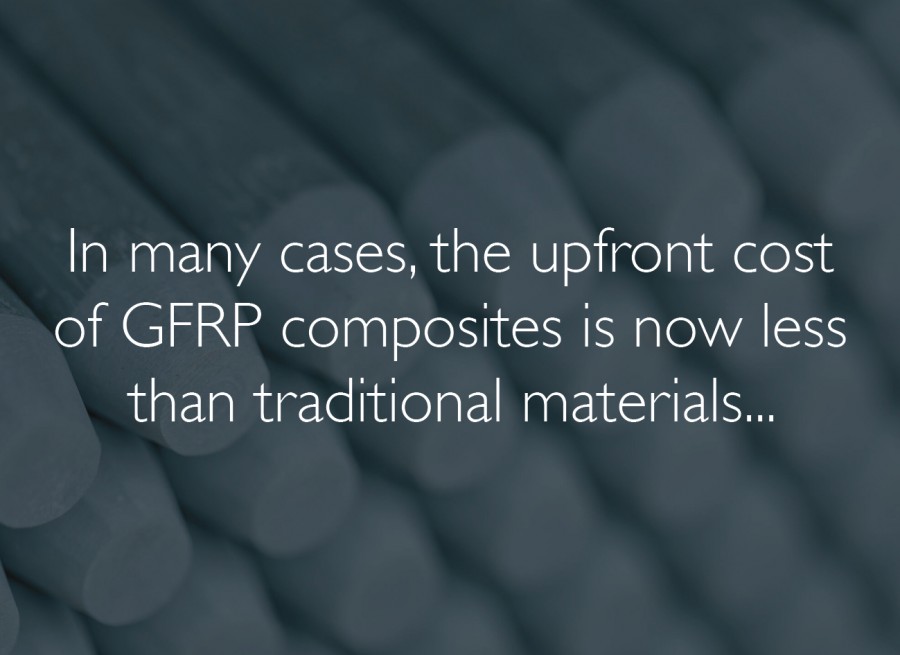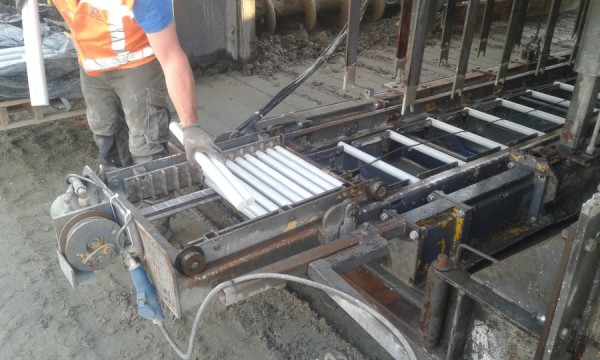Cost Savings with FRP Composites

Glass fiber-reinforced polymer (GFRP) composites are an increasingly popular material choice. One of the big drivers of this demand is the reduced upfront cost of GFRP products over the last two decades.
Increasing economic pressures, consumer demand, and the need for sustainable practices are encouraging companies and government agencies to look beyond the status quo. Traditional materials are now being surpassed by GFRP products which can deliver optimal cost savings and performance throughout the whole life-cycle of a product.
GFRP products cost-effective compared to other materials
Wood is heavy and eventually rots, steel is expensive and rusts – GFRP composites are replacing both, often as critical structural or industrial components.
The increased use of GFRP pultrusions has led to significantly larger, more efficient production runs, which has in turn allowed pultrusion manufacturers to pass these savings on to the customer. For example, the real cost of Mateenbar™ from Pultron’s factory has been reduced by over 50% in the last 15 years.
Such reductions have made GFRP composites a cost-effective option when compared to other materials. This is the result of continued technology breakthroughs within the pultrusion industry:
- Increased sizes of production runs have allowed pultrusion manufacturers to invest in R&D to improve efficiencies in the manufacturing process. The process is now faster and with less waste. At Pultron, all our machinery is custom-built to ensure consistent output and speed.
- Making pultruded composite products requires little power and water throughout the entire process.
- Steel prices have skyrocketed and aluminum prices are experiencing a 13-year high. Raw materials have not increased in price to the same extent as steel and aluminum. In many cases, the upfront cost of GFRP composites is now less than traditional materials.
They deliver whole-of-life cost savings
The reduction in material cost is great news for the pultrusion industry and its customers. But whole-of-life savings is where GFRP composites continue to deliver the greatest value.
The cost of the product is only part of the equation when assessing commercial viability. Other considerations include:
- labor
- transportation
- other materials and additives: for example, concrete structures with GFRP rebar often require less concrete cover and no expensive additives for rust prevention.
- operational costs
- maintenance and repair
- life-cycle
- decommissioning.
Considering the cost of an asset across the lifetime is now seen as 'best practice' as opposed to focusing on the initial upfront cost. The International Institute for Sustainable Development states that whole-of-life costing changes the procurement mindset from the “best value for money” to the “best value across the asset life cycle”. This approach is better for asset owners, the environment, and communities in the long term.
At Pultron, our purpose is to produce customized composite solutions that are commercially viable and deliver durability, efficiency, and costs. These typically involve replacing traditional materials that do not deliver the best price-performance ratio.
Wood is heavy and eventually rots, steel is expensive, and rusts – GFRP composites are replacing both, often as critical structural or industrial components.
Case study: How strengthening with FRP made economic sense at the Port of Rotterdam

Ports are under increasing pressure to move freight quickly and with no disruption to the schedule. Shipping delays caused by construction delays, equipment breakage, and concrete repairs will inevitably have a costly domino effect throughout the supply chain.
Engineers working on the terminal upgrade at Europe’s busiest port, Port of Rotterdam (pictured) specified Mateendowel™ to be used in the concrete slabs to manage this risk.
Mateendowel™ is a corrosion-free joint system used in roading and replaces steel and stainless steel dowels. Savings will be achieved over the entire life cycle of the port:
- Reduced Installation Costs. Mateendowel™ is lightweight (4x lighter than steel) making it safer to handle and faster to install.
- Reduced pre-preparation and materials. The smooth surface of the dowel has low bond strength. There is no need to grease dowels or add bond breaker sleeves (which would be required for steel). Saving is incurred on labor costs and pre-preparation materials.
- No future maintenance and limited construction delays. The corrosion-resistant properties of pultruded GFRP composite dowels offer long life. Because they do not rust, they do not expand causing concrete breakage (spalling) and needing immediate repair, forcing downtime at this busy port.
- Increased design life. Mateendowel™ is corrosion-resistant and chemical-resistant. It is expected to last for more than 100 years.
The Highly Durable Alternative
Steel corrosion has a huge impact on the economy and environment. According to NACE International, the cost of corrosion globally is estimated to be US$2.5 trillion.
The corrosion-resistant properties are well-known but FRP materials deliver strengthened structures. Companies and government agencies are now choosing these materials over steel to eliminate the risk of corrosion.
When a structure cannot withstand the environmental elements, the result is increased cost in maintenance and early replacement. The cost of maintenance, as discussed in our feature GFRP composite rebar delivers sustainable and resilient infrastructure, and can account for up to 60% of the total cost of an infrastructure project.
They are Lightweight
GFRP materials are four times lighter than steel and only 70% of the density of aluminum. They are light and strong. In fact, the strength-to-weight ratio is four times that of high tensile steel.
The low density and lightweight properties mean the cost of transportation is significantly reduced.
Savings are also gained on labor, equipment, and installation. GFRP composites are easier to install, and lighter to lift. Expensive lifting equipment is often not necessary.
These savings can be significant, typically varying from 20% to more than 50% in some cases.
FRP Material Technology is Future Ready
With upfront costs lower than ever, there are opportunities to improve on what has been done before or investigate GFRP composite for the future.
It’s exciting to see what will be next in the world of pultrusion.
Have questions about composites and pultrusion? Get in touch.
About the author: Pete Renshaw is the Business Development Director at Pultron and serves as the Chief Technical Officer for Mateenbar Limited. He has over 25 years of experience working with pultruded composite product development.